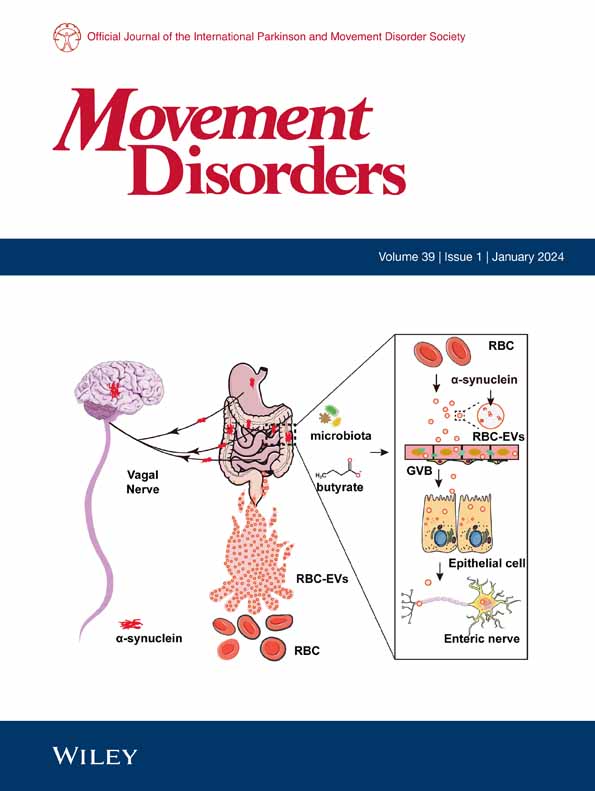丘脑下核的低/高多频刺激可改善帕金森病患者的语言流畅性,维持运动控制
IF 7.4
1区 医学
Q1 CLINICAL NEUROLOGY
引用次数: 0
摘要
背景:高频丘脑下核深部脑刺激(STN - DBS)是帕金森病(PD)运动症状的一种公认的治疗方法,然而,其对非运动症状的影响仍存在争议。低频DBS可以改善认知,但对运动功能的影响是有害的。我们的目的是评估双频STN - DBS结合高低频(130 + 10 Hz)对言语流畅性(VF)的影响,与130 Hz或10 Hz单独刺激和OFF刺激相比。对运动症状、工作记忆和主观感觉的影响也进行了评估。方法:采用双盲设计,采用随机顺序的实验条件,对18例伴有STN - DBS的PD患者进行130 Hz、10 Hz和130 + 10 Hz刺激与OFF刺激的效果进行比较。在每个条件下,参与者完成:音素和动作VF, N - back任务,以及疲劳和压力水平的视觉模拟量表。运动功能和步态速度也进行了评估。我们进行了Friedman方差分析,以确定在三种刺激条件下,我们的主要(VF)和次要结果测量(运动功能,N - back任务,主观感受)的基线OFF刺激的变化分数是否不同。结果130 + 10 Hz组vf改善程度高于130 Hz组(P = 0.006);130 + 10 Hz和10 Hz之间无差异(P = 0.2), 130HZ和10 Hz之间无差异(P = 0.6)。不同刺激条件对运动评分的影响差异有统计学意义(χ2(2) = 11.1, P = 0.004), 10 Hz刺激条件下的运动评分差于130 Hz (P = 0.002)和130 + 10 Hz (P = 0.01)。结论双频STN - DBS在改善PD的音位VF的同时,对PD的运动体征保持了有益的作用。©2025作者。Wiley期刊有限责任公司代表国际帕金森和运动障碍学会出版的《运动障碍》。本文章由计算机程序翻译,如有差异,请以英文原文为准。
Low/High Multi‐Frequency Stimulation of the Subthalamic Nucleus Improves Verbal Fluency Maintaining Motor Control in Parkinson's Disease
BackgroundHigh frequency deep brain stimulation of the subthalamic nucleus (STN‐DBS) is a well‐established therapy for Parkinson's disease (PD) motor symptoms, however, its effect on non‐motor symptoms is controversial. Low frequency DBS can improve cognition, but its effects on motor functions are detrimental.ObjectiveOur goal was to evaluate the effect on verbal fluency (VF) of dual frequency STN‐DBS combining high and low frequency (130 + 10 Hz) as compared to 130 Hz or 10 Hz alone and to OFF stimulation. The effect on motor symptoms, working memory, and subjective feelings was also assessed.MethodsWe used a randomized order of experimental conditions with a double‐blind design to assess the effects of 130 Hz, 10 Hz, and 130 + 10 Hz stimulation as compared to OFF stimulation in 18 PD patients with STN‐DBS. In each condition, participants completed: phonemic and action VF, N‐back task, and visual analogue scales for fatigue and stress level. Motor functions and gait velocity were also assessed.Friedman analysis of variance were conducted to determine whether change scores from baseline OFF stimulation, in our primary (VF) and secondary outcomes measures (motor functions, N‐back task, subjective feelings) were different in the three stimulation conditions.ResultsVF improved more in the 130 + 10 Hz condition than 130 Hz condition (P = 0.006); there was no difference between 130 + 10 Hz and 10 Hz (P = 0.2) and between 130HZ and 10 Hz (P = 0.6). There was a significant difference among the stimulation conditions for the motor score (χ2 (2) = 11.1, P = 0.004), it being worse at 10 Hz than 130 Hz (P = 0.002) and 130 + 10 Hz (P = 0.01).ConclusionsDual frequency STN‐DBS improves phonemic VF while maintaining a beneficial effect on motor signs of PD. © 2025 The Author(s). Movement Disorders published by Wiley Periodicals LLC on behalf of International Parkinson and Movement Disorder Society.
求助全文
通过发布文献求助,成功后即可免费获取论文全文。
去求助
来源期刊

Movement Disorders
医学-临床神经学
CiteScore
13.30
自引率
8.10%
发文量
371
审稿时长
12 months
期刊介绍:
Movement Disorders publishes a variety of content types including Reviews, Viewpoints, Full Length Articles, Historical Reports, Brief Reports, and Letters. The journal considers original manuscripts on topics related to the diagnosis, therapeutics, pharmacology, biochemistry, physiology, etiology, genetics, and epidemiology of movement disorders. Appropriate topics include Parkinsonism, Chorea, Tremors, Dystonia, Myoclonus, Tics, Tardive Dyskinesia, Spasticity, and Ataxia.
 求助内容:
求助内容: 应助结果提醒方式:
应助结果提醒方式:


